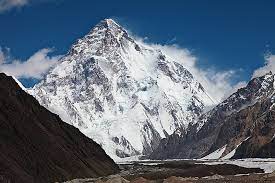Pakistan is home to some of the world’s most impressive and awe-inspiring mountain peaks. In fact, four of the 14 highest independent peaks in the world (the eight-thousanders) are found in Pakistan! Out of a total of 108 peaks above 7,000 metres and 4555 above 6,000 metres, these four independent peaks are truly remarkable. In this blog post, we will take a look at the four highest independent peaks in Pakistan and explore their beauty, significance, and history.
K2: 8,611 m
K2, also known as Mount Godwin-Austen or Chhogori, is the second-highest peak in the world and the highest peak in Pakistan. Located on the China–Pakistan border in the Gilgit-Baltistan region of the Karakoram mountain range, it is one of the world's most challenging climbs due to its great height and dangerous terrain.
The mountain was first surveyed by surveyor T.G. Montgomerie in 1856. He gave it the designation K2 after noting that it was the second peak of the Karakoram Range. The local name for the mountain is Chogori, which translates as "The Great Mountain."
At 8,611 meters (28,251 ft) above sea level, K2 is a technical climb, requiring expert mountaineering skills and extensive experience in high-altitude climbing. On July 31, 1954, Italians Lino Lacedelli and Achille Compagnoni became the first people to reach the summit of K2, an achievement that was recognized by the King of Italy, who awarded them both the Order of Merit of the Italian Republic. Since then, more than 300 people have successfully climbed to the top of K2 but many have failed in their attempts and some have died in the process.
Despite its technical difficulty, K2 has gained a reputation as a "holy grail" among mountaineers due to its sheer beauty and challenging nature. Its fame continues to draw climbers from around the world and for this reason, it is considered one of the most sought-after mountains to climb.
Nanga Parbat: 8,126 m
Nanga Parbat, meaning "Naked Mountain" in Urdu, is the ninth highest mountain in the world at 8,126 m (26,660 ft). It is located in the Gilgit-Baltistan region of Pakistan, and is part of the Himalayan mountain range. The mountain has two main peaks, Rakhiot Peak (8,126 m) and Mazeno Peak (7,824 m), and is one of the most difficult mountains to climb in the world.
The first successful ascent of Nanga Parbat was made by German climber Hermann Buhl in 1953. Since then, the mountain has seen numerous successful ascents, though it has been the site of tragedy as well. In 1970, an avalanche on Nanga Parbat killed 27 people and in 2013 11 mountaineers were killed on the mountain when an icefall collapsed on them.
Despite its deadly reputation, Nanga Parbat remains a popular mountain for experienced mountaineers. The mountain has two major routes that lead to the summit. The Rakhiot Flank is a more technical route that is typically used for winter ascents, while the Diamir Face is the more popular route, with plenty of fixed ropes and camp sites along the way.
Regardless of which route you take, Nanga Parbat is sure to challenge you with its breathtaking beauty and punishing climbs.
Gasherbrum I: 8,080 m
Gasherbrum I, also known as Hidden Peak, is the 11th highest peak in the world. Located in Gilgit-Baltistan, Pakistan, this peak is part of the Gasherbrum Massif, a large group of mountains located in the Karakoram Range.
At 8,080 meters (26,500 ft) tall, it is the highest peak in the Gasherbrum Massif and the third highest independent peak in Pakistan. Its steep slopes are composed of ice and snow, making it a particularly challenging mountain to climb.
Gasherbrum I was first climbed on July 5, 1958 by an Austrian-American expedition led by Fritz Moravec. It has since been climbed several times by various expeditions.
The mountain offers stunning views of its surroundings, including the Baltoro Glacier and other peaks of the Karakoram Range. The area around the peak is also home to some of the world's most stunning high-altitude lakes, such as Snow Lake.
For those interested in mountaineering, Gasherbrum I presents an exciting challenge. The climb is technical, but attainable with proper preparation and experience. Whether you're an experienced climber or just starting out, this peak is sure to provide a memorable experience!
Broad Peak: 8,051 m
Broad Peak, at 8,051 meters, is the twelfth-highest peak in the world. It is located on the Pakistan-China border in the Karakoram mountain range. The peak was first climbed in 1957 by a German-Austrian expedition led by Fritz Wintersteller.
The Broad Peak massif is composed of three distinct peaks: Broad Peak (main), Broad Peak Central and Broad Peak North. The summit is quite broad and flat, hence its name. The mountain's South face is steep, offering technical climbing challenges. The summit offers spectacular views of some of the highest mountains in the world, including K2, Gasherbrum I and II, and Nanga Parbat.
Climbing Broad Peak requires extensive physical and technical preparation. It has become a popular climb for mountaineers due to its accessibility and relatively low technical difficulty compared to other 8,000 meter peaks. However, it is still a formidable undertaking that requires a high level of fitness and endurance. The best time to climb Broad Peak is between June and August when temperatures are more moderate.
Broad Peak is considered a dangerous mountain due to its avalanches and unpredictable weather conditions. As such, experienced mountaineers should take all necessary precautions before attempting to climb the peak.


No comments yet